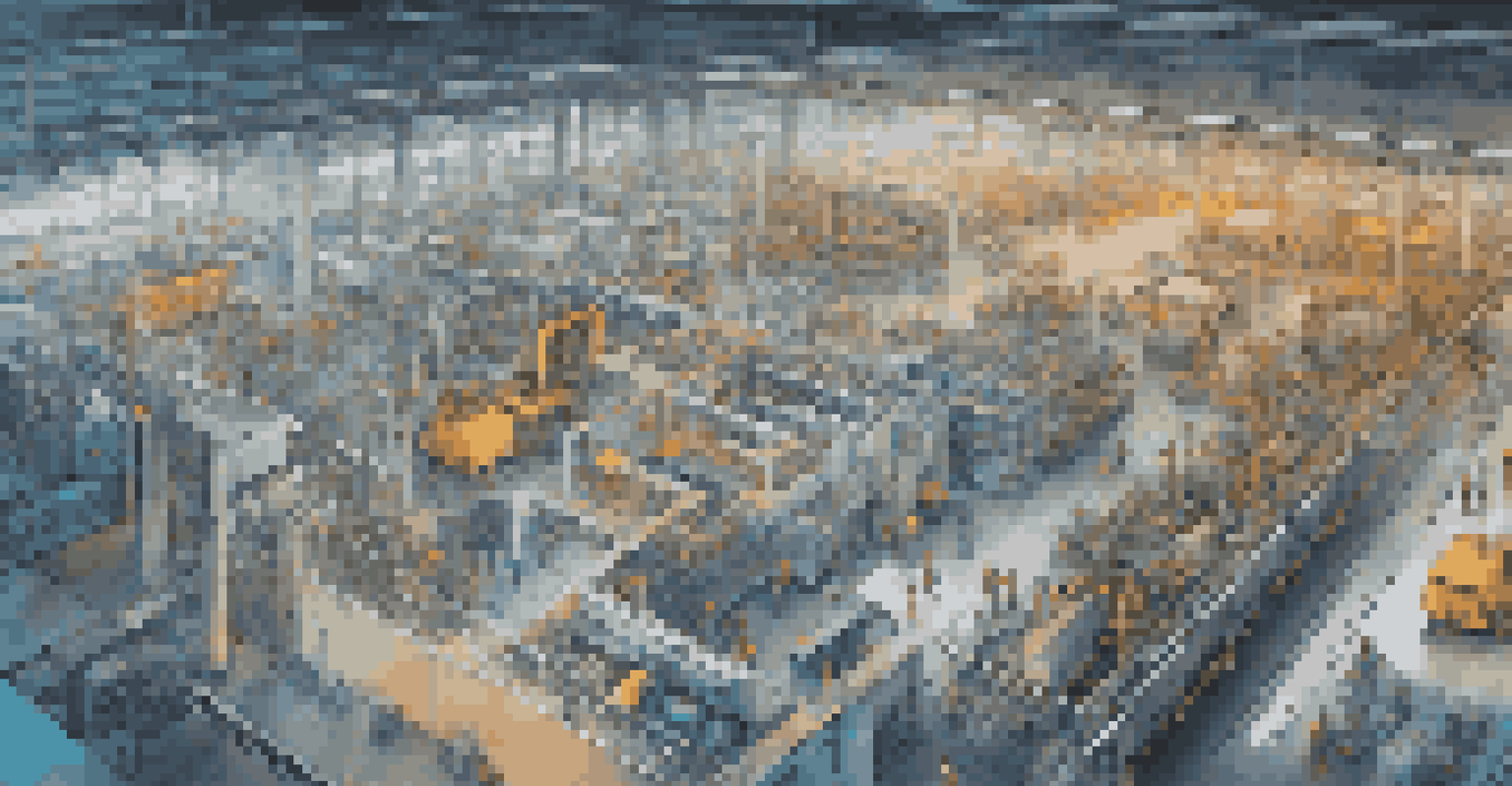The ROI of AI Implementations in Predictive Maintenance

Understanding Predictive Maintenance and AI
Predictive maintenance is a proactive approach that uses data analysis to forecast when equipment might fail. By leveraging AI, organizations can analyze vast amounts of data collected from machinery to identify patterns and predict issues before they arise. This not only minimizes unexpected downtime but also extends the lifespan of equipment, leading to significant cost savings.
The best way to predict the future is to create it.
AI plays a crucial role in predictive maintenance by employing machine learning algorithms to refine predictions over time. For instance, if a machine is showing signs of potential failure, AI can analyze historical performance data to determine the likelihood of that failure and recommend timely interventions. This intelligent analysis transforms maintenance from a reactive to a proactive strategy.
Moreover, the integration of AI with IoT devices enhances data collection, providing real-time insights into equipment conditions. This synergy enables organizations to make informed decisions, reducing the need for costly emergency repairs and improving operational efficiency. Understanding this relationship is key to realizing the full potential of AI in maintenance.
Calculating the ROI of AI Implementations
Calculating the return on investment (ROI) from AI implementations in predictive maintenance involves considering both direct and indirect benefits. Direct benefits can be quantified through reduced downtime, lower maintenance costs, and improved equipment performance. For example, if a factory reduces unplanned downtime by 20% due to predictive maintenance, that translates to substantial savings.

On the flip side, indirect benefits, such as enhanced employee productivity and improved safety, are just as crucial. When maintenance staff can rely on timely alerts and insights from AI systems, they can focus on strategic tasks rather than firefighting issues. This boost in efficiency not only leads to cost savings but also fosters a more engaged workforce.
AI Enhances Predictive Maintenance
By using AI to analyze data, organizations can predict equipment failures and optimize maintenance schedules.
A comprehensive ROI analysis should also account for the initial investment in AI technology and training. While there may be upfront costs, the long-term savings and operational benefits typically outweigh these expenses. To truly understand the value of AI in predictive maintenance, organizations should look beyond immediate costs and consider the broader impact on their operations.
Case Studies: Success Stories in AI and Predictive Maintenance
Real-world examples can illuminate the tangible benefits of AI in predictive maintenance. For instance, a leading manufacturing company implemented AI-driven predictive analytics and reported a 30% reduction in maintenance costs within the first year. By predicting equipment failures accurately, they were able to schedule maintenance during non-peak hours, minimizing disruptions to production.
In the world of technology, the future is always a few steps ahead, and those who embrace change will lead the way.
Another notable case is in the aviation industry, where an airline adopted AI to monitor the health of its aircraft engines. By utilizing predictive maintenance strategies, they achieved a significant decrease in unscheduled maintenance events, allowing them to enhance fleet availability. This not only improved customer satisfaction but also contributed to lower operational costs.
These success stories highlight how AI can transform maintenance practices across various industries. The key takeaway is that organizations willing to invest in AI technologies can reap substantial rewards, improving efficiency and driving down costs in the long run.
Challenges in Implementing AI for Predictive Maintenance
While the benefits of AI in predictive maintenance are clear, the journey to implementation is not without challenges. One major hurdle is data quality; AI models require clean, accurate data to function effectively. Organizations must invest in data management and ensure that their sensors and equipment are properly calibrated to collect reliable information.
Another challenge lies in the integration of AI with existing systems. Many organizations have legacy systems that may not easily accommodate new technologies. To overcome this, businesses often need to adopt a phased approach, gradually integrating AI solutions while ensuring compatibility with their current infrastructure.
Calculating AI ROI is Essential
Understanding both direct and indirect benefits of AI in predictive maintenance is crucial for justifying investments.
Additionally, there may be resistance from employees who are apprehensive about AI taking over their jobs. It's essential for organizations to foster a culture of collaboration, emphasizing that AI is a tool to assist and empower employees rather than replace them. Addressing these challenges head-on can pave the way for successful AI adoption in predictive maintenance.
Best Practices for Implementing AI in Maintenance
Implementing AI in predictive maintenance requires a strategic approach. First and foremost, organizations should start with a clear understanding of their goals and objectives. This involves assessing current maintenance practices and identifying areas where AI could add value, such as reducing downtime or improving asset utilization.
Next, investing in the right technology and tools is crucial. Organizations should select AI platforms that align with their specific needs and ensure compatibility with existing systems. Partnering with technology providers who specialize in AI for industrial applications can offer valuable insights and support during the implementation process.
Finally, training and upskilling employees is vital for a successful transition. Providing staff with the necessary training to interpret AI-generated insights will empower them to make informed decisions. By cultivating a collaborative environment, organizations can harness the full potential of AI in predictive maintenance.
Future Trends in AI and Predictive Maintenance
The future of AI in predictive maintenance is both exciting and promising. As technology advances, we can expect to see more sophisticated AI algorithms that can analyze data in real-time, providing even more accurate predictions. This shift towards real-time analytics will enable organizations to respond to potential issues instantaneously, further minimizing downtime.
Another trend is the integration of AI with augmented reality (AR) for maintenance tasks. Technicians equipped with AR glasses could receive real-time data and visual instructions from AI systems while performing maintenance. This combination could enhance efficiency and reduce human error during repairs.
Future Trends in AI Maintenance
Advancements in AI and IoT will lead to real-time analytics and improved maintenance practices across industries.
Moreover, as the Internet of Things (IoT) continues to expand, the volume of data available for analysis will grow exponentially. This wealth of information will drive AI advancements, allowing for more nuanced insights into equipment health and performance. Organizations that stay ahead of these trends will be well-positioned to maximize their ROI from AI in predictive maintenance.
Conclusion: Embracing AI for Long-Term Success
In conclusion, the ROI of AI implementations in predictive maintenance is substantial, making it a worthwhile investment for organizations across industries. By adopting AI technologies, businesses can enhance operational efficiency, reduce costs, and improve overall equipment reliability. The transition may come with challenges, but the long-term benefits are undeniable.
As companies continue to navigate the complexities of digital transformation, embracing AI in maintenance strategies will be essential for staying competitive. The journey may require careful planning, investment in technology, and a commitment to employee training, but the rewards are significant.

By leveraging AI for predictive maintenance, organizations not only future-proof their operations but also create a safer and more efficient working environment. With the right approach, the ROI from AI can contribute to sustained growth and success in the ever-evolving landscape of industry.